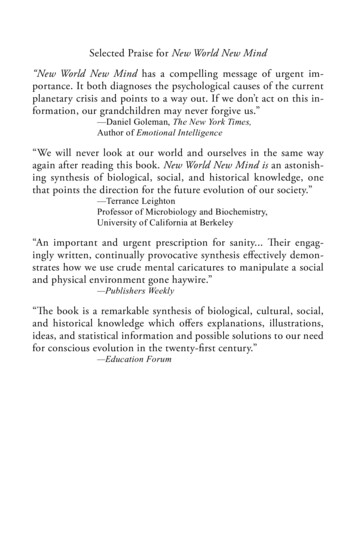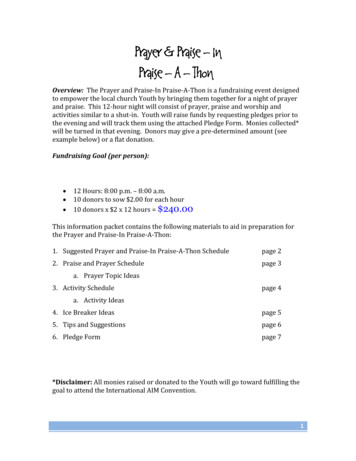
Transcription
Selected Praise for New World New Mind“New World New Mind has a compelling message of urgent importance. It both diagnoses the psychological causes of the currentplanetary crisis and points to a way out. If we don’t act on this information, our grandchildren may never forgive us.”—Daniel Goleman, The New York Times,Author of Emotional Intelligence“We will never look at our world and ourselves in the same wayagain after reading this book. New World New Mind is an astonishing synthesis of biological, social, and historical knowledge, onethat points the direction for the future evolution of our society.”—Terrance LeightonProfessor of Microbiology and Biochemistry,University of California at Berkeley“An important and urgent prescription for sanity. Their engagingly written, continually provocative synthesis effectively demonstrates how we use crude mental caricatures to manipulate a socialand physical environment gone haywire.”—Publishers Weekly“The book is a remarkable synthesis of biological, cultural, social,and historical knowledge which offers explanations, illustrations,ideas, and statistical information and possible solutions to our needfor conscious evolution in the twenty-first century.”—Education Forum
NEW WORLDNEW MINDMOVINGTOWARDCONSCIOUSEVOLUTIONRobert OrnsteinPaul Ehrlich
This is a Malor BookPublished by ISHKP 0 Box 176, Los Altos, CA 94023Copyright @ 1989, 2000, 2111by Robert Ornstein and Paul EhrlichAll Rights Reserved. Including the right of reproduction in whole or in part in anyform.First published by Doubleday, 1989Second edition published by Simon & Schuster, 1990Malor Paperback published by ISHK, 2000eBook published by ISHK, 2011Library of Congress Cataloging in Publication Data:Ornstein, Robert E. (Robert Evan), 1942New world new mind : moving toward conscious evolution /Robert Ornstein, Paul Ehrlich.p. cm.Includes bibliographical references and index.ISBN 1-883536-24-31. Human ecology. 2. Environmental policy. 3. Human evolution.I. Ehrlich, Paul R. II. Title.GF50 .076 2000304.2-dc2100-061080
F O R S A L LY A N D A N N E
AcknowledgmentsWE WOULD LIKE to thank Ginger Barber, D. Loy Bilderback(Department of History, Fresno State University), Ann Bowcock(Department of Genetics, Stanford University Medical School),Brent Danninger (Legal Economic Evaluations), Jared M. Diamond(Department of Physiology, UCLA School of Medicine), John P.Holdren (Energy and Resources Group, University of California,Berkeley), Terry Leighton (Department of Microbiology, University of California, Berkeley), Christina Lepnis (Stanford University),Mary Ann Mason (Lone Mountain College), Evan Neilsen (LawOffices of George Nowell), David Widdicombe (Queens Counsel,London), and Darryl Wheye (Menlo Park, California) for readingand commenting on the manuscript.Pat Brown, Shane DeHaven, Carol Holland, Pam Nakaso, andSteve Masley helped with various aspects of preparation of the manuscript. The staff of Stanford’s Falconer Biology Library skillfullytracked down several obscure references. Christina Lepnis contributed valuable research.We are especially grateful to our wives, Anne Ehrlich and SallyMallam, who not only worked diligently on the manuscript, butalso supplied other assistance essential to maintaining our sanitywhile we completed it.Finally, we should note that the order of our names on the coverwas determined by the toss of a coin and that we shared equally inthe writing of this book.ix
ContentsCHAPTER IThe Threat Within the Triumph1SECTION ITHE WORLD THAT MADE US AND THE WORLDWE MADECHAPTER 2The World That Made Us17CHAPTER 3The World We Made40SECTION 2THE MATCHED AND THE MISMATCHED MINDCHAPTER 4Caricatures of Reality: How the Mind Is Mismatched69CHAPTER 5Where Defaults Harm: Daily Life Decisions94CHAPTER 6Outgrowing the Truth Fairy: Medico-, Psycho-,and Mystico-Therapies119
CHAPTER 7Managing a World Long Gone: The Old Mind inPolitics, the Environment, and War150SECTION 3NEW WORLD NEW MINDCHAPTER 8The Beginnings of Real Change189CHAPTER 9A Curriculum About Humanity197CHAPTER 10Changing the World Around Us234APPENDIXNotes and SourcesINDEX267287
ITHE THREATWITHIN THE TRIUMPHIT ALL SEEMS to be happening at once. A small groupof terrorists murder a few Americans far away—and fearof getting murdered changes the traveling habits of millions.But Americans continue to slaughter more people each day withhandguns than all the people the terrorists have killed up to thewriting of this book. No one does anything about it.1
T h e T h r e aT W i T h i n T h e T r i u m p h2People swamp AIDS testing centers, desperate and anxious toknow if they are carrying the virus. If they have it, it will likely killthem. Can society even care for AIDS victims?Meanwhile populations explode, stockpiles of nuclear weaponsgrow, budget deficits mount, our education becomes more andmore obsolete, and the environment—on which our very existencedepends—deteriorates. But most people’s attention is fixed uponeye-catching “images,” such as the taking of the Iran hostages, horrible murders, airplane crashes, changes in stock prices, and footballscores. Cancer terrifies us, yet we keep on smoking. Oliver Northtestifies that he lied—yet his good looks and smooth talk lead manypeople to propose that he run for President.And the President operates the same way. Ronald Reagan, by hisown admission, perverted an important U.S. global policy becausehis mind was similarly fixed on another set of hostages. He said, “Ilet my preoccupation with the hostages intrude into areas where itdidn’t belong. The image, the reality of Americans in chains, deprivedof their freedom and families so far from home, burdened my thoughts.And this was a mistake.” [italics ours]Why does the growing budget deficit attract relatively little attention while the comparatively meaningless stock market “crash”makes headlines? Why do many popular writers yearn for a returnto an education suitable for Oxford men before World War I, whenthe world has changed in critical ways to a greater extent sinceWorld War II than it changed between the birth of Christ and thatwar? Why do the numbers of nuclear weapons expand astronomically but largely unheralded, while a small girl trapped in a wellcommands the front pages? Why do we collectively spend billionson medical care while neglecting the simple preventative actionsthat, if we took them, would save many times the lives?We believe it is no accident.All these things are happening now, and are happening all at once,in part because the human mental system is failing to comprehend themodern world. So events will, in our opinion, continue to be outof control until people realize how selectively the environment impresses the human mind and how our comprehension is determined
T h e T h r e aT W i T h i n T h e T r i u m p h3by the biological and cultural history of humanity. These unnoticedyet fundamental connections to our past, and how we can retrainourselves for a “new world” of the future, one filled with unprecedented threats, are what this book is about.We are writing this book in an effort to help decision makers, educators, physicians, businessmen, and concerned citizens to changetheir “minds”—not in the conventional sense, but rather to changethe way they make decisions. We don’t think there is any panaceafor all the problems of society; nothing simple that we can do rightnow is guaranteed to prevent a nuclear war or avoid the next plague.Everything, unfortunately, cannot be solved by one book! But wedo think that if people understood the fundamental roots of ourmany problems, they might begin to change in a direction thatcould secure the human future.Today’s situation is unprecedented, but the human situation hasoften been unprecedented. In part, successfully facing the unprecedented has distinguished human beings from other forms of life.Since they spread out of Africa, people have always created newenvironments for themselves; they have always had to adapt to newand unexplored territory.There is a difference now, though. At no previous time have people had the capacity to destroy their civilization in a few hours andto ruin much of the planet’s life-support systems in the process.And never before has a species been engaged, as are we, in the process of destroying those systems wholesale in a “gradual” mannerthat could complete the job in less than a century.But fortunately there is still time to change. Scientific evidencedeveloped over the past three decades illuminates many aspects ofthe nature of both the human mind and the human predicament,and points the way to the changes needed. This evidence is drawnfrom many disciplines, including evolutionary biology, neuroscience, cognitive science, climatology, and geochemistry.We believe that the only permanent means of resolving the paradox that our minds are both our curse and our potential salvationis through conscious change. Our biological evolution, includingthe physical evolution of our brains, is much, much too slow to
T h e T h r e aT W i T h i n T h e T r i u m p h4help. And the undirected evolution of our culture, in view of thedemands being placed on it, is still too sluggish and often inappropriate. Both biological and cultural evolution are inadequate toadapt us to the environments we are creating.We don’t perceive the world as it is, because our nervous systemevolved to select only a small extract of reality and to ignore the rest.We never experience exactly the same situation twice, so it wouldbe uneconomical to take in every occurrence. Instead of conveyingeverything about the world, our nervous system is “impressed” onlyby dramatic changes. This internal spotlight makes us sensitive tothe beginnings and endings of almost every event more than thechanges, whether gigantic or tiny, in the middle.The perception of dramatic changes begins deep within the nervous system, amid simple sensing such as seeing light. Put a threeway bulb (50-100-150 watts) in a lamp in a dark room. Turn on thelamp: the difference between darkness and the 50-watt illuminationis seen as great; but the increase from 50 to 100 and from 100 to150 seems like almost nothing. Although the change in the physicalstimulus is exactly the same, you notice it less and less as each 50watts are added. Turn off the lamp, even from the 50-watt setting,however, and you feel it immediately! We notice the beginning andthe end and overlook the greater changes in the middle.You might be thinking that this analysis of lamps and sensing lightis very far removed from the major dilemmas of our current world.But our point is that many of the predicaments of our society comeabout from the way people respond to, simplify, and, ultimately,“caricature” reality in their minds. Our caricature emphasizes thedramatic and distinctive features of events, in the same way as a cartoon caricature of a politician might exaggerate Lyndon Johnson’soutsize ears, Richard Nixon’s ski-jump nose, Mikhail Gorbachev’sforehead birthmark.This simplified focus on the dramatic is now out of date in complex modern life; the same routines of internal analysis that originally developed to signal abrupt physical changes in the old worldare now pressed into service to perceive and decide about unprecedented dangers in the new. Scarce and unusual items, be they a
T h e T h r e aT W i T h i n T h e T r i u m p h5headline news event, a one-day dress sale, or a chance for peace,come into the mind through the same old avenues and are filteredand judged in the same old way.This mismatched judgment happens in the most basic as well asthe most momentous situations. In psychology experiments, a wordat the beginning of a list heard once is recalled 70 percent of thetime, words in the middle less than 20 percent, and words at theend almost 100 percent. In 1980, presidential candidate RonaldReagan illustrated these principles. He said: “Politics is just likeshow business. You need a big opening. Then you coast for a while.Then you need a big finish.” Reagan is renowned for his politicalsavvy.The same sensitivity to sharp changes gets called into play in judging the most important, life-or-death essentials. Consider this: thefirst atomic bombs were kept secret and then were unveiled suddenly. The mushroom clouds over Hiroshima and Nagasaki, andthe sudden vast destruction they caused signaled a sharp change inthe world. The new threat was readily noticed and properly feared.But two responses indicate that humanity did not perceive thisimportant change in the world correctly. First, that atomic explosion on Hiroshima made a far greater impression than the muchgreater destruction and death visited upon Tokyo by conventionalincendiary bombs, since burning cities seen from the air (in newsreels) had by then become routine and so were ignored.And, second, since the first frightening explosions, nuclear weapons have accumulated gradually until they now number in the tensof thousands, and most of them are ten to a hundred times morepowerful than those that devastated Hiroshima and Nagasaki. Ourminds are inhibited in noticing the threat; the continuing accumulation of gigantic arsenals doesn’t get the same attention as the firstweapons. Only public relations events, new “beginnings” like thenuclear winter announcement, or the showing of the TV film TheDay After, can reattract old minds—and then only temporarily untilhabituation sets in again.The human nervous system, well matched to a world in whichsmall, sharp changes were important but large gradual ones were
T h e T h r e aT W i T h i n T h e T r i u m p h6not, is inadequate to keep attention focused on this most ominousnuclear trend. Our nervous system and our world are mismatchednow. The original image of a single nuclear detonation signaled anawesome threat. Graphs and tables describing the sizes of arsenalsfail to produce a comparably realistic understanding; occasionalnews events have only temporary effects on most people. Our response to nuclear armaments has followed the Reagan caricature.The big opening was Hiroshima; now we’re coasting; with lots ofluck we may avoid the big finish.A set of hydrogen bombs joined to an intercontinental ballisticmissile is one of the ultimate triumphs of biological and culturalevolution. Think of it: humanity, whose own origins were as a fewrelatively large molecules in a tiny droplet in a primitive sea, hasnow itself developed the power to annihilate much of life on Earth.But why? Why have we done it? Why, on a planet that has anexploding population, a deteriorating environment, and massivesocial problems, has the only genuinely creative species invested somuch time, energy, and genius in building arsenals that can only beused to destroy itself?Why has humanity not redirected its efforts instead into seekingways for people to live together without conflict and to limiting thesize of its population so that everyone can lead a meaningful life?Why hasn’t humanity tried vigorously to preserve the earth thatpeople and all living species depend upon?The answers to these kinds of questions are not simple. The dilemmas will not be “solved” by the next political campaign, government program, educational critique, or international conference.They are to no small degree problems of how we perceive our environment and ourselves.The problem has much deeper roots than most people envision.To trace its history will take us into the world in which our speciesevolved, into the world that made us. That world has produced inus certain ways of interpreting our surroundings, ways that onceenhanced our survival. But these “old ways” are not necessarilyadaptive in a world that is utterly different from the one in whichour ancestors lived.
T h e T h r e aT W i T h i n T h e T r i u m p h7Some scientists recognized our evolutionary mismatch decadesago, but their insight has had as yet little effect. On May 23, 1946,Albert Einstein sent a telegram to President Roosevelt on behalf ofthe Emergency Committee of Atomic Scientists saying, in reference to nuclear explosions, “The unleashed power of the atom haschanged everything save our modes of thinking, and thus we drifttowards unparalleled catastrophe.” The power of human destructiveness is far greater forty years after the Hiroshima and Nagasakiexplosions that prompted Einstein’s statement, yet human thoughtprocesses still remain largely unchanged.The weapons in the United States and Soviet strategic arsenalsnow contain enough explosive power that, if packaged as Hiroshima-sized bombs, they could blow up one Hiroshima each hour formore than a lifetime (seventy-eight years)!To recognize how extraordinary human history is, we must reset our idea of time: in evolutionary time, a million years is notvery much. Given the time scale of the history of the Earth, whichcondensed from cosmic gases and dust about 4.6 billion years ago,humanity has evolved and multiplied with unprecedented speed. Inonly a few million years human beings have spread from the African plains to inhabit every part of the planet. Humanity has grownfrom scattered groups of a few thousand to a mob of over 5 billion.Suppose Earth’s history were charted on a single year’s calendar,with midnight January 1 representing the origin of the Earth andmidnight December 31 the present. Then each day of Earth’s “year”would represent 12 million years of actual history. On that scale,the first form of life, a simple bacterium, would arise sometime inFebruary. More complex life-forms, however, come much later; thefirst fishes appear about November 20. The dinosaurs arrive aroundDecember 10 and disappear on Christmas Day. The first of ourancestors recognizable as human would not show up until the afternoon of December 31. Homo sapiens—our species—would emerge atabout 11:45 P.M. All that has happened in recorded history wouldoccur in the final minute of the year.It’s been a long evolutionary climb, one taking several billion
T h e T h r e aT W i T h i n T h e T r i u m p h8years, from our evolutionary origins in the sea to our ability tomake and deliver hydrogen bombs.The mental machinery of human beings developed almost entirelybefore that fateful final “minute.” And that, we maintain, is whatmakes it extremely difficult for us to diagnose our major problems,let alone to solve them. It is still possible, however, to change theway we perceive the world, to change the way that humanity thinks,and thus to survive.Hundreds of thousands or millions of years ago, our ancestors’survival depended in large part on the ability to respond quickly tothreats that were immediate, personal, and palpable: threats like thesudden crack of a branch as it is about to give way or the roar of aflash flood racing down a narrow valley. Threats like the darkeningof the entrance to the cavern as a giant cave bear enters. Threats likelightning, threats like a thrown spear.Those are not threats generated by complex technological devicesaccumulated over decades by unknown people half a world away.Those are not threats like the slow atmospheric buildup of carbondioxide from auto exhausts, power plants and deforestation; notthreats like the gradual depletion of the ozone layer; not threats likethe growing number of AIDS victims.In this book we’ll say a great deal about threats—the dangers tous, to our civilization, to the very capacity of the earth to support human life—that exist because we have changed the world socompletely. We’ll concentrate on the difficulties our minds have ininterpreting and even perceiving the new kinds of threats and responding appropriately to them.In our view, there are several parts to the human quandary: The world that made us is now gone, and the world we made isa new world, one that we have developed little capacity to comprehend.The old world for which our perceptual systems were “designed”was one where the overall environment was a relatively stable, limited one in which threats were signaled by short-term changes andaction was usually required immediately. Consider the branchflood-bear kinds of threats that our human progenitors faced over
T h e T h r e aT W i T h i n T h e T r i u m p h9millions of years of evolutionary history. Apes, australopithecines(our first upright ancestors), early human hunters and gatherers,and the inhabitants of early civilizations, like other animals, hadevolved quick reflexes to deal adequately with such threats.The benefits of having evolved “quick reflexes” also accrue today;in modern life we also must often react quickly. On hearing a cracking sound from our chair, we are instantaneously apprehensive andready to act. If a child lurches into the street ahead of our car, wehit the brakes before even thinking about it. If we’re not half-witted, thunderclaps over the golf course tell us to put the clubs awayquickly and retreat to the clubhouse for a drink. An unexpectedintruder into our home arouses an automatic series of responsesthat we interpret as fear and a physical necessity to fight or flee.These are all reactions that would serve us well against bear, burglar,breaking branch, or downpour. All nonhuman species evolved to fit into their physical habitats,and people originally evolved to do this as well. Human beings,however, have changed the world more in the last ten thousandyears than their ancestors did in the preceding 4 million. Muchmore than any other species, we have turned the tables on thephysical environment and made it change to fit us. Clothing, fire,dwellings, and agriculture all enabled people to live where nonecould before. Modern human beings have left their evolutionaryhome in subtropical Africa to live all over the earth, in the freezingwinters of Alaska as well as in the scorching deserts of the MiddleEast. More importantly, human beings have built entirely new environments: farms, villages, towns, crowded cities, ocean liners, evenunderwater dwellings, and more. Human beings can even live forbrief periods away from earth itself. The human experience has been one of expanding creations andadaptations. This cyclic pattern spooled us, in an evolutionary instant, from small groups of hunters and gatherers into a complexcivilization. Agriculture led to the construction of cities and thepopulation explosion. Cities led to epidemics of the diseases ofcrowding and to large-scale warfare. Public health measures led tofurther increases in population and then, by permitting people to
T h e T h r e aT W i T h i n T h e T r i u m p h10live longer, to an increase in cancer and heart diseases. Cities alsoled to universities and the uncovering of many secrets of the universe. And uncovering secrets of the universe led to Hiroshima andChernobyl.And the pace of change itself becomes even faster. Next month theworld population will increase by more than the number of humanbeings that lived on the planet 100,000 years ago, a time when evolution had already produced a human brain almost indistinguishable from today’s model. In the next 4 years alone more people willbe added to the Earth than made up the entire population living atthe time of Christ. It is difficult to comprehend this kind of world,and most people, too many, have been unable to do so. Humaninventiveness has created problems because human judgment andhumanity’s ability to deal with the consequences of its creations lagsbehind its ability to create. There is now a mismatch between the human mind and theworld people inhabit. The mismatch interferes with the relationships of human beings with each other and with their environments. Our species did not evolve to comprehend the problemsassociated with gigantic numbers of people—yet 5 billion humanbeings now occupy the Earth.Human beings, like all other organisms, have to adapt to the environments in which they live. For most of the history of life ourancestors evolved biologically, as do all living things. (Biologicalevolution consists of changes in the information encoded in ourgenes. It typically operates over thousands of generations.) Then,for the relatively brief period of human prehistory and history—afew million years—adaptation took place primarily by means ofcultural change: the development of language and tools; the invention of agriculture, cities, industry, and high technology.Cultural evolution can be much more rapid than biological, forit involves alterations of information stored in minds or in books,tools, art, and other artifacts of societies. Cultural evolution canmake significant changes in a matter of decades or less. But therapid changes human beings are making in the world now havemade even the pace of most cultural evolution far too slow.
T h e T h r e aT W i T h i n T h e T r i u m p h11As a result we are losing control of our future. The serious anddangerous mismatch is this: civilization is threatened by changestaking place over years and decades, but changes over a few years ordecades are too slow for us to perceive readily. That is a time scaletoo leisurely for a nervous system attuned to bears, branches, burglars, and downpours. At the same time, the changes are much toorapid to allow biological or cultural evolutionary processes to adaptpeople to them. We are out of joint with the times, our times. The rate of change in the world around us is increasing. Humanity is refashioning the world so quickly now that each decade’senvironment differs dramatically from that of the last. Each triumph of technology contains new kinds of threats. With the adventof television and other modern communications, we can even feelthreatened by events, such as terrorist acts, occurring thousands ofmiles away.The physiological tendency is to respond to them immediately,as if they were local emergencies, while at the same time we ignoresome occurrences such as the gradual increase in homeless peopleor thinning of the ozone layer, that really are serious threats to usor our neighbors. Thus our old mental system struggles and oftenfails to distinguish the relevant from the trivial, the local from thedistant, just as the ability to make such distinctions is becomingincreasingly crucial. The human mental “hardware”—our senses and brains—is effectively fixed. That hardware equips us with what we call the oldmind. Although we are evolving, our mental machinery will notchange biologically in time to help us solve our problems. The samemental routines that originally signaled abrupt physical changes in theold world are now pressed into service to perceive and decide aboutunprecedented dangers in the new.In saying this we don’t mean to downgrade our accomplishments;indeed it is human inventiveness that causes our major dilemma.Our minds now conquer challenges and tasks that appear to haveno parallels in our evolutionary past; we read and write, learn morethan one spoken language, use word processors, and design and flyaircraft. But none of these tasks represents a break with the standard
T h e T h r e aT W i T h i n T h e T r i u m p h12animal pattern of planning to reach short-term goals. Many of ourhighest achievements represent, then, a refinement of the old mind,not a new kind of perception. They cause significant changes in ourenvironment decade by decade, but they are generally responses toperceived immediate needs, not to changes happening over decades.We cleverly develop more fuel-efficient cars when gasoline pricessuddenly rise. When they drop, we relax fuel-efficiency standards,even though careful analysis indicates that much higher gasolineprices are a near certainty in coming decades.Like those of other animals, our brains evolved to understandonly a small portion of the world, the portion that most affectsour capacity to survive and reproduce. Each animal, whether a bee,butterfly, frog, chimp, or human being, lives within its own “smallworld,” which is a mere caricature of the outside world. This simplecaricature of the environment, as we shall see, sufficed for mostorganisms in most environments, for most people throughout history; and it still works for many people. But it is fatally obsolete ina world where much more explosive power can now be carried inone nuclear submarine than has been detonated in all wars so far.To retrain ourselves requires a radical shift in our normal way ofperceiving ourselves and our environment: we have to look at ourselves in the long view and understand an evolutionary history ofmillions of years rather than the fleeting “history” that is taught. Weneed to be “literate” in entirely new disciplines, such as probabilitytheory and the structure of thought, rather than just learning moreabout the sequences of English monarchs.The time has come to take our own evolution into our hands andcreate a new evolutionary process, a process of conscious evolution.The human predicament requires a different kind of education andtraining to detect threats that materialize not in instants but inyears or decades—we need to develop “slow reflexes” to supplementthe quick ones. We need to replace our old minds with new ones.It will not be nearly as exciting as fighting a bear or running away,not a simple speedy solution that can be summed up in a slogan.The remedy will demand a sustained, persistent, and complex effort. We need to learn to perceive and respond to the slow changes
T h e T h r e aT W i T h i n T h e T r i u m p h13in the size of human populations, the increasing extinction of otherspecies, and the proliferation of nuclear weapons. These and othersuch gradual alterations of our world are threats much more dangerous than hostages, mass murderers, lightning bolts, and drunkendrivers.
Selected Praise for New World New Mind "New World New Mind has a compelling message of urgent im-portance. It both diagnoses the psychological causes of the current . Including the right of reproduction in whole or in part in any form. First published by Doubleday, 1989 Second edition published by Simon & Schuster, 1990










